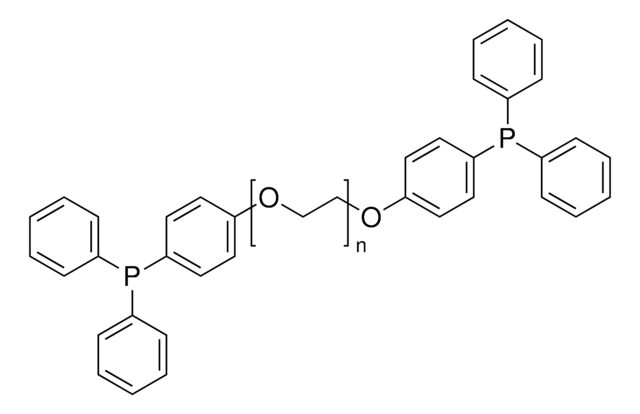93092
Triphenylphosphine
≥95.0% (GC)
Synonyme(s) :
Phosphorustriphenyl
About This Item
Produits recommandés
Densité de vapeur
9 (vs air)
Niveau de qualité
Pression de vapeur
5 mmHg ( 20 °C)
Pureté
≥95.0% (GC)
Forme
crystals
Capacité de réaction
reaction type: Buchwald-Hartwig Cross Coupling Reaction
reaction type: Heck Reaction
reaction type: Hiyama Coupling
reaction type: Negishi Coupling
reaction type: Sonogashira Coupling
reaction type: Stille Coupling
reaction type: Suzuki-Miyaura Coupling
Pertinence de la réaction
reagent type: ligand
Impuretés
~3% triphenylphosphine oxide
Point d'ébullition
377 °C (lit.)
Pf
77-84 °C
79-81 °C (lit.)
Solubilité
water: soluble 0.00017 g/L at 22 °C
Groupe fonctionnel
phosphine
Chaîne SMILES
c1ccc(cc1)P(c2ccccc2)c3ccccc3
InChI
1S/C18H15P/c1-4-10-16(11-5-1)19(17-12-6-2-7-13-17)18-14-8-3-9-15-18/h1-15H
Clé InChI
RIOQSEWOXXDEQQ-UHFFFAOYSA-N
Vous recherchez des produits similaires ? Visite Guide de comparaison des produits
Catégories apparentées
Description générale
Application
- The palladium-based complexes bearing 1, 3-dibenzylbenzimidazolium with morpholine, triphenylphosphine, and pyridine derivate ligands: This study discusses the synthesis and characterization of new palladium-based complexes incorporating triphenylphosphine, providing insights into their potential catalytic activities (Aktaş et al., 2022).
- Polymer-supported triphenylphosphine: This review highlights the diverse applications of polymer-supported triphenylphosphine in organic synthesis and its significant role in promoting more sustainable and efficient chemical processes (Moussa et al., 2019).
- Application prospects of triphenylphosphine-based mitochondria-targeted cancer therapy: The review focuses on the utilization of triphenylphosphine for developing mitochondria-targeted drugs, emphasizing its potential in cancer therapy (Cheng et al., 2023).
Mention d'avertissement
Danger
Mentions de danger
Conseils de prudence
Classification des risques
Acute Tox. 4 Oral - Eye Dam. 1 - Skin Sens. 1B - STOT RE 1 Inhalation
Organes cibles
Central nervous system,Peripheral nervous system
Code de la classe de stockage
6.1C - Combustible acute toxic Cat.3 / toxic compounds or compounds which causing chronic effects
Classe de danger pour l'eau (WGK)
WGK 2
Point d'éclair (°F)
356.0 °F - closed cup
Point d'éclair (°C)
180 °C - closed cup
Équipement de protection individuelle
dust mask type N95 (US), Eyeshields, Faceshields, Gloves
Faites votre choix parmi les versions les plus récentes :
Déjà en possession de ce produit ?
Retrouvez la documentation relative aux produits que vous avez récemment achetés dans la Bibliothèque de documents.
Les clients ont également consulté
Notre équipe de scientifiques dispose d'une expérience dans tous les secteurs de la recherche, notamment en sciences de la vie, science des matériaux, synthèse chimique, chromatographie, analyse et dans de nombreux autres domaines..
Contacter notre Service technique














